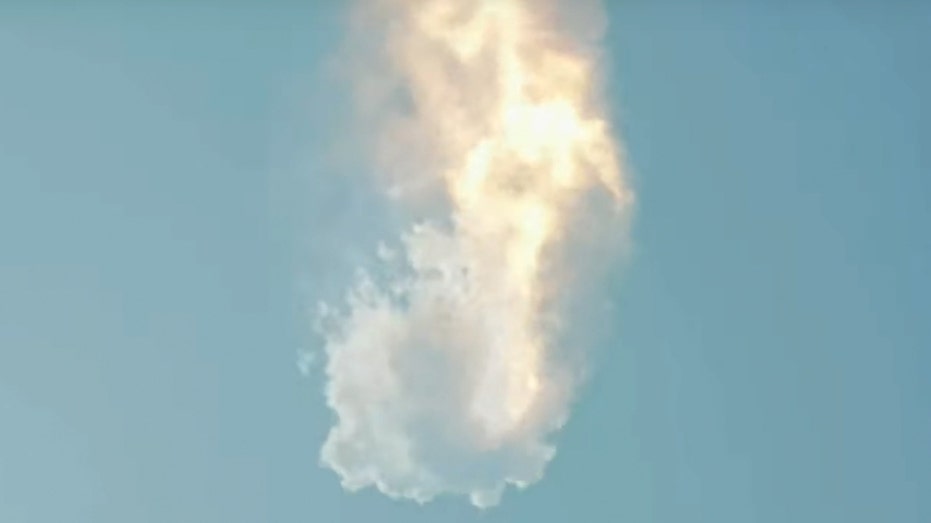SpaceX successfully launches giant Starship rocket, explodes minutes later
NASA has reserved the nearly 400-foot-tall rocket for its next moonwalking mission
SpaceX launches first test flight of world's most powerful rocket before Starship explodes in midair
SpaceX sent its massive Starship up in a monumental test flight before the world's most powerful rocket exploded. (Courtesy: SpaceX)
SpaceX's Starship — the biggest and most powerful rocket ever built — blasted off from the southern tip of Texas on Thursday morning.
However, just minutes later and awaiting stage separation, it experienced a failure — what SpaceX livestream hosts described as a "rapid unscheduled disassembly."
The rocket began to tumble and then exploded four minutes into the flight, plummeting into the Gulf of Mexico.
The cause of the failure was not immediately clear.
"Congrats @SpaceX team on an exciting test launch of Starship! Learned a lot for next test launch in a few months," SpaceX founder Elon Musk tweeted a short time later.
SpaceX said on Twitter that its teams would continue to review data and work toward the next flight test.
"With a test like this, success comes from what we learn, and today’s test will help us improve Starship’s reliability as SpaceX seeks to make life multi-planetary," it said.

In a still image from video, SpaceX's next-generation Starship spacecraft atop its powerful Super Heavy rocket self-destructs after its launch from the company's Boca Chica launchpad on a test flight near Brownsville, Texas, on Thursday. (SpaceX/Handout via Reuters / Reuters Photos)
It marked the first launch of the Starship's two sections together and comes after the first attempt was scrubbed on Monday due to a problem that occurred during fueling.
FAA SAYS IT'S LOOKING FOR WAYS TO OPTIMIZE LAUNCHES, REENTRIES AS MORE ROCKETS SOAR TO SPACE
A stuck valve needed to pressurize the first-stage booster forced the team to scrap the launch.
While Starship is designed to be fully reusable, none of the nearly 400-foot-tall rocket would be recovered.

In a still image from video, SpaceX's next-generation Starship spacecraft atop its powerful Super Heavy rocket lifts off from the company's Boca Chica launchpad on a test flight near Brownsville, Texas, on Thursday. (SpaceX/Handout via Reuters / Reuters Photos)
If the flight went as planned, the first-stage booster, or the Super Heavy, would drop into the Gulf of Mexico. This is the inaugural Super Heavy flight. The spacecraft on top would eventually pass over the Atlantic before coming down near Hawaii.
The flight was expected to last for just an hour and a half.
SpaceX plans to use the Starship — and its 16.7 million pounds of thrust — to send people and cargo to the moon and Mars. This test flight was not carrying people or satellites.
GET FOX BUSINESS ON THE GO BY CLICKING HERE
Early versions of the upper stage rocketed into the stratosphere, landing upright for the first time in 2021.
Musk estimates that there is an 80% chance that one of the fleets of Starships under construction will reach orbit by the end of the year. He expects that it will take a couple of years to achieve full and rapid reusability.

The SpaceX Starship lifts off from the launchpad during a flight test from Starbase in Boca Chica, Texas, on Thursday. (PATRICK T. FALLON/AFP via Getty Images / Getty Images)
The Federal Aviation Administration awarded SpaceX a launch license last week. The license is valid for five years.
The agency's decision was criticized by the American Bird Conservancy, which blasted the company's operations for allegedly damaging important coastal bird habitats, showing a picture of a plover next to debris in Boca Chica.
CLICK HERE TO READ MORE ON FOX BUSINESS
"SpaceX operations continue to damage important coastal bird habitats at Boca Chica in south Texas," Mike Parr, the president of the American Bird Conservancy, said in a statement. "We believe that Cape Canaveral offers a much lower environmental impact option, and is underutilized with less than one launch per month currently despite having six active launch pads and more pads that could be made available."
NASA has reserved a Starship for its next moonwalking team — which could come as early as 2025 — and rich tourists are already booking lunar flybys.
The Associated Press contributed to this report.
